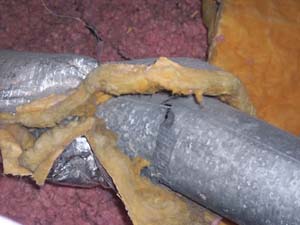Ductwork
In some houses, and certainly in mine, improperly installed or sealed ductwork is a major contributor to energy loss. Especially when the ductwork is run in the attic and/or basement through unconditioned space, you can lose up to 50% of the efficiency of the system. In my case, the sheathing on the outside on some of the 20 year old ductwork had split and cracked, exposed the insulation of the tube. I’ve systematically replaced each run of the flexible ductwork with the newer and more energy efficient foil ductwork. My biggest find though was in the duct tape that I had originally used to seal the flex to the main trunk and to the duct boots (at the ceiling and floor registers.)
All of the ‘stick’ of the tape had long since expired, and the tape was only hanging on out of habit. So, when installing the new flexible ductwork, I pulled back the insulation from the end of the flex insulation,
pulled it over the metal connector, and used mastic to seal the joint. I then pulled the insulation back over the joint and used ties to clamp down the ductwork to the connecting metal. The mastic is fun to use – it’s easy to apply with a brush and you don’t have to make it look pretty! I also used the mastic to seal all the joints in the metal main trunk and at the connection of the trunk to the HVAC unit. Finally, I removed all the floor and ceiling registers, applied mastic on the inside of the ‘boot’ at the joints in the metal, and then reinstalled the registers.
Stay tuned – more on energy efficient renovation in our next blog!

